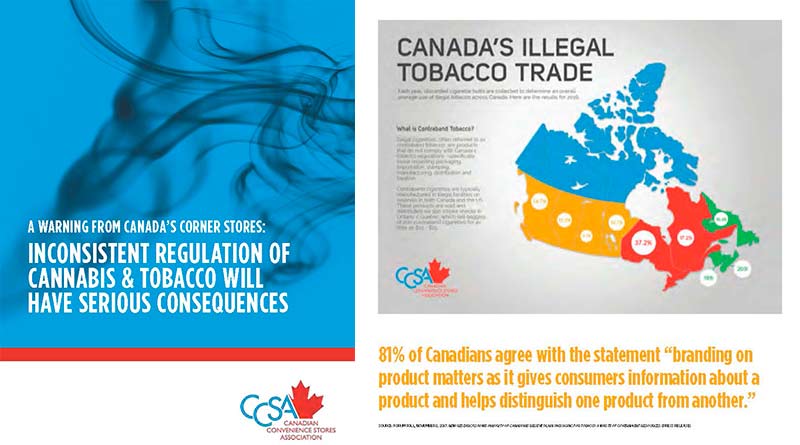Plain Pack: Satinder Chera Hard At Work Pressing Ottawa Not To Penalize C-Stores
The year 2017 ended without Bill S-5 on vaping and plain packaging of tobacco products being passed by the House of Commons.
According to Satinder Chera, President of the Canadian Convenience Stores Association (CCSA), 2019 is now the soonest retailers could feel the impact of this new piece of legislation.
In an interview with DepQuébec, the main advocate of Canada’s 25,000 c-stores expressed concerns about the many impacts of this Bill on the retailers’ business model given that it addresses both vaping and tobacco packaging. And all this while the Federal government is busy legalizing cannabis!
“Our concern is simple: the playing field must remain fair for convenience stores,” said Satinder Chera.
Yet, the provisions on plain packaging and vaping are still very vague because everything ultimately depends on a regulation that will be drafted once the law is adopted and about which we know almost nothing
And when it comes to plain packaging, the CCSA President stresses that the government is going against the logic of its own cannabis policy:
- in one case (cannabis), the Federal government legalizes mainly to curb the illegal market, insists provincial taxes must remain low for this purpose and supports the display of brands on cannabis products to better distinguish the legal offering from the illegal one;
- in the other case (tobacco), it is quite the opposite: the government supports various measures of prohibition, raises taxes in defiance of contraband and aims at eliminating brands from tobacco packaging without a second thought about how that could affect the illegal market.
“The adoption of plain packaging alone will have a huge impact on the 25,000 convenience stores’ operations in Canada, and we are very concerned,” said the president.
In a special brief on this issue (see illustration below), the CCSA highlights the government’s lack of coherence but above all, the significant impact of its plain pack Bill on retailers’ operations (see also this infographic on the topic):
- Plain packaging (ie tobacco packages without brands with the exception of a small 12 point helvetica inscription) will impact customer service by making it slower and much more difficult;
- It will lead to security problems, because staff will spend more time picking out the right products, and less time keeping an eye on the rest of the store;
- The need for training will necessarily be increased and will require more supervision and time for employers, which translates into higher operating costs (multiplied by 25,000 convenience stores);
- And because the products are poorly identified, plain packaging will cause stores to order the wrong products and in some cases customers will get the wrong products.
It is therefore a significantly larger effort that retailers will have to provide to continue selling this product and serving customers well.
The impact will also be enormous since the legislation will force manufacturers to completely redo the packaging of all their products. This will force retailers as well to get rid of all their inventory at some date, a quite complex, expensive and demanding operation.
And because the devil is in the details, it is all based on the regulations that will be adopted by Health Canada in relation to this legislation, once it is passed.
Indeed, only the fine print will tell what the Bill really means by “plain and standardized”: plain display surely, but also standard packaging? And what about cigarette content? Filters? Markings on cigarettes? We are currently in complete limbo on these specifics.

As for the vaping part, the Bill will finally allow retailers to sell vaping fluids with nicotine, but again, a lot depends on the adopted provisions, particularly with respect to promotion and brands.
“Whether we like it or not, tobacco is still an important part of convenience store revenues. The government has a duty to ensure that retailers have a fair access to alternatives such as vape products,” said Chera.
From the Senate to the House of Commons
First presented in the Senate, Bill S-5 landed in the House of Commons last spring and passed first reading. It is at second reading that things get real since it is at this stage that MPs really take a hard look at it and listen to stakeholders’ point of view (retailers, manufacturers and health groups, mainly) during public hearings, after which the Bill goes back to the House for a third reading.
No one knows when the second reading will take place: it could be in the coming Spring as well as next year … it all depends on the government’s legislative agenda.
Once public hearings are over and if there is no amendment to the Bill, it will be voted on and sanctioned quickly.
After a transition period estimated at about one year, it could then be put into effect somewhere in 2019 (most likely in the second half).
On the other hand, if amendments are required to the Bill, it will go back to the Senate for review and this could delay the process by several months. It is therefore conceivable that the Bill will not be adopted before the next Federal election expected in 2019.
This could mean postponing its adoption for several years, even possibly killing it in the event of a change of government. Then it would be anybody’s guess.






